Pediatric wheelchairs are durable and versatile, giving children with disabilities the freedom to partake in any childhood activity as much as an able-bodied child.
Of course, that depends on the wheelchair, as there are numerous options on the market with varying features to accommodate different lifestyles and physical conditions.
In our pediatric wheelchair guide, we give you a detailed breakdown of what to consider, so you can make the most informed decision for your child.
Pediatric Wheelchair Overview
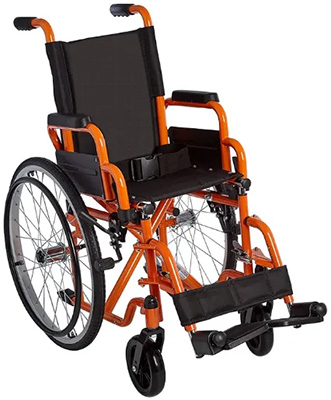
Pediatric wheelchairs are mobility devices for children. These chairs come in many different designs and can be customized to fit the child’s specific needs.
While these wheelchairs are more or less smaller versions of standard adult models, there are a few highly significant differences.
For example, since children continuously grow, some chairs have adjustable components, so the device “grows” with the child.
Then there are other factors, such as how transportation plays into the picture, especially regarding school and activities.
The right pediatric wheelchair aligns with your child’s lifestyle and personality while keeping them comfortable and safe.
Fortunately, modern pediatric chairs are multi-functional – enabling the child to sit, stand, or lay down. There are manual and power chairs to accommodate any type of disability, and they also come in vivid colors instead of boring grey or brown like adult wheelchairs.
In this pediatric wheelchair guide, we’ll go over the different things to consider when making your decision. But first and foremost, the best starting point is talking with a medical professional about your child’s abilities and goals. They can offer the best advice on the right device.
The medical professional should be able to tell you which control system is the most ideal.
They establish this by assessing the child’s physical abilities and skills, taking note of how well they can control their upper and lower body. Posture support is also taken into account to pinpoint the best seat and cushion for development.
Now, we’ll get into what to consider when choosing a pediatric wheelchair.
What to Consider When Choosing a Pediatric Wheelchair
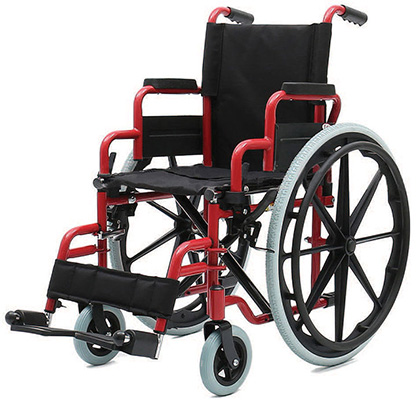
Picking the best pediatric wheelchair starts with evaluating your child’s physical abilities.
Do they rely on a little or a lot of physical support? Are they highly active? How accessible are the home and school?
These are just a few examples of what to think about when perusing the market, where there are several different types of devices, all accommodating users in a variety of ways.
For instance, if a child has a strong upper body, they probably won’t need a lot of back or head support. In that case, a manual wheelchair is a viable option.
If your child is into sports and is highly active, lightweight pediatric wheelchairs are fast and highly maneuverable for most activities.
Let’s take a look at the other considerations.
Cost and Financing
Pediatric wheelchairs vary greatly in price depending on the materials, design, and modifications. But as far as physical and mental development is concerned, price shouldn’t be the main priority.
Talking with your medical provider can give you ideas of the most cost-effective solutions, and you can also reach out to your insurance provider to see if coverage is available.
Transportation
One factor you don’t want to overlook is transportation, as this can either be a piece of cake or a complicated affair depending on the type of wheelchair being transported.
Generally, both manual and electric pediatric chairs are too large to fit inside a car trunk. However, there are lightweight models on the market that fold for easy transport, but this depends on whether it’s the right type of chair for your child.
If the chair doesn’t fit in your car, you’ll have to invest in separate equipment, such as a lift, or you can modify a van/SUV to be wheelchair accessible.
Indoors and Outdoors
Take a moment to walk around your house and pay attention to the layout. Are the doorways narrow? Are there tight turns and lots of furniture? How about elevated thresholds?
Remember that you’ll be maneuvering your child from place to place within the house, transferring them to a chair, bed, or sofa. In this case, a lightweight manual chair is a good fit for indoor use.
Wheelchairs can also be customized with detachable hardware to enable the child to get as close to a chair or bed as possible for a transfer that puts less strain on the back.
If your child attends school on campus, talk with the administration to assess mobile accessibility. Don’t forget to touch base with your child’s doctor on the best features to make indoor maneuverability easier.
There are also all-terrain wheelchairs for children who play sports. These wheelchairs are built using lightweight materials with wider wheels and deeper traction.
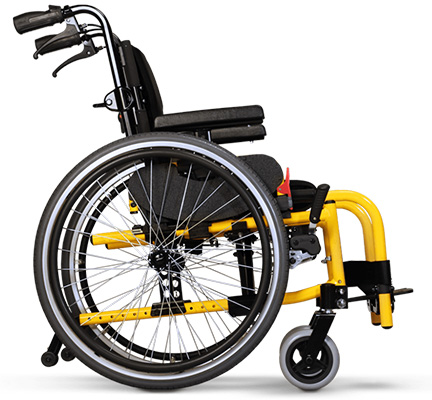
Size
The sizing of a pediatric wheelchair is imperative since a child is growing every year. In other words, it shouldn’t just fit, but it should also be comfortable, safe, and offer developmental support.
Once again, it’s best to discuss this with your doctor and refer to a pediatric wheelchair size chart for reference. Also, remember that components can be modified to meet your child’s needs.
The seat is one component to pay attention to, as it should be wide enough to carry the child without making it difficult for them to reach the push rims.
For maximum comfort, there should also be at least two inches measured between the front of the seat and the back of the child’s knee.
When evaluating the height, adjust the seat so that the child can place both of their feet flat on the ground.
The footrests and armrests should enable your child to achieve a comfortable grip if needed.
Regarding growth, you can invest in a new wheelchair once your child outgrows their old one. However, many pediatric wheelchairs come with adjustable components that “grow” with the child, enabling them to stick with the same chair for up to 10 years.
These components include back supports and expanding frame sections that accommodate an increase in weight by cross balancing the chair.
Pediatric Wheelchair Accessories
Finally, you’ll want to consider adding accessories to the wheelchair that enhance your child’s comfort and mobility. Here are some popular options:
- Door openers: This gives your child the independence to open and move through a door on their own without having to wait on someone to open it for them.
- Extra storage: There are attachable bags that come in different sizes.
- Cup holders: These are also detachable.
- Harness: Chest and shoulder straps can help improve posture.
- Extended brake: This is an easily accessible backup for the user in case the original brake handle is too difficult to reach.
- Pediatric wheelchair gloves: High-quality leather gloves protect the child’s hands when propelling a manual wheelchair forward.
Next up, we’ll go over the different types of pediatric wheelchairs for any type of lifestyle!
Different Types of Pediatric Wheelchairs
Like adult wheelchairs, pediatric versions offer a variety of features that pertain to a wide range of disabilities, environmental factors, and daily activities.
We’ll give you a brief overview of each type and the benefits they offer to children on the go!
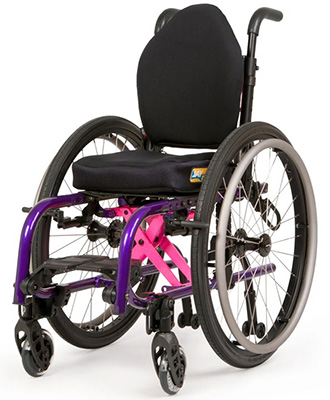
Pediatric Manual Wheelchair
This is the standard pediatric wheelchair that works best for indoor use and can be lightweight for easy transport.
While this is typically a pushrim system that relies on arm strength for mobility, there is the option of a Hemi frame that enables children with limited upper-body mobility to propel themselves using leg strength.
Manual wheelchairs can be customized as needed to fit the child. We also describe the basic manual models below:
- Small pediatric wheelchair: This is a standard manual chair designed for children under six years old.
- Junior wheelchair: These manual chairs are designed for children over six years, featuring adjustable components to accommodate growth.
- Sports wheelchairs: This model is lightweight, designed to be durable, and easily maneuverable for physical activities.
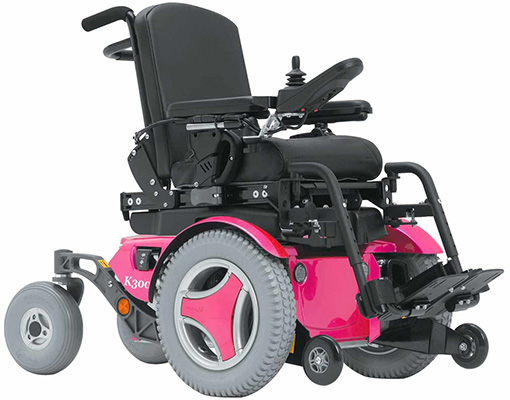
Pediatric Power Wheelchair
On the other side of the ring, we have the pediatric motorized wheelchair, which gives children with limited upper body strength the power to move on their terms.
Interestingly, it’s only recently that pediatric electric wheelchairs became widespread. The prior belief was that power controls were too complex for children to use and could potentially hinder their development.
However, research has proven that this isn’t the case. In fact, powerchairs actually promote independence and boost confidence.
There are options for lower-speed controls that can be changed out as the child grows older to allow for safer handling.
Pediatric powerchairs come with the same wheel configurations as adult powerchairs, including:
- Rear-wheel drive: This enables more speed but less maneuverability in tight spaces.
- Front-wheel drive: This setup is slower but allows for sharp turning in tight spaces.
- Mid-wheel drive: There is less stability, but it provides the tightest turning capacity out of the three types.
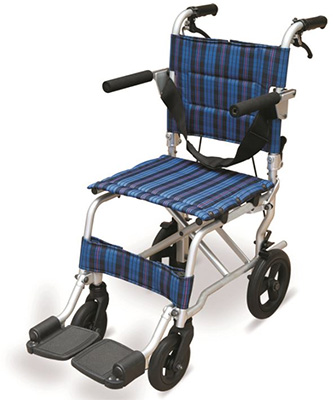
Pediatric Transport Chair
A pediatric transport wheelchair comes in handy for families that travel frequently. It’s lightweight, foldable, and depending on the model, comes with adjustable parts.
Note that transport wheelchairs are not meant to be used as everyday mobility devices but rather for traveling short distances from one point to another with the help of a caregiver.
Pediatric Wheelchair Strollers
For young children who are too small for a wheelchair, strollers can be adapted as a replacement until the child can shift into a pediatric chair.
Pediatric stroller wheelchairs are a suitable alternative since they are lighter and flexible, especially for transportation. They also fit easily through most doorways and in narrow hallways.
Customizing a stroller to accommodate a disability can be ordered through a wheelchair supplier after consulting with a medical professional.
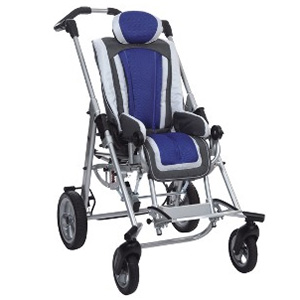
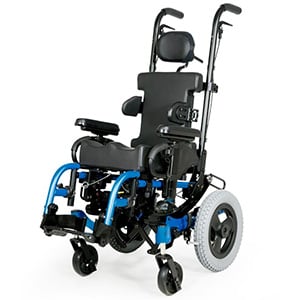
Pediatric Tilt-In-Space Wheelchair
These specialized pediatric wheelchairs feature adjustable backrests that tilt back at a 45-degree angle from a mechanical pivot point.
This design improves posture while enabling the user to enjoy enhanced respiratory function and line of sight.
Final Thoughts: Pediatric Wheelchair Guide
Navigating the pediatric wheelchair market can feel overwhelming. But when armed with the right knowledge, you can find the best model for your child, customized to suit their physical capabilities and lifestyle.
The best starting point for information would be to consult with a medical professional, who will thoroughly assess your child’s physical abilities, taking into consideration their continuing development.
Resources & References: